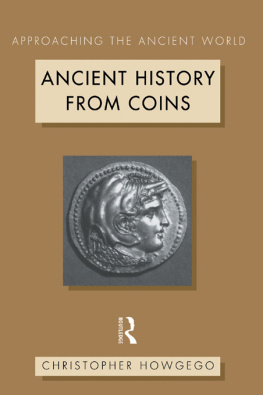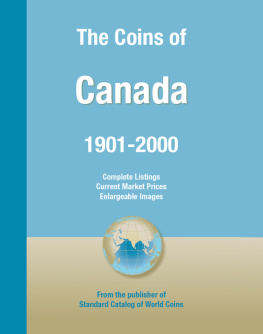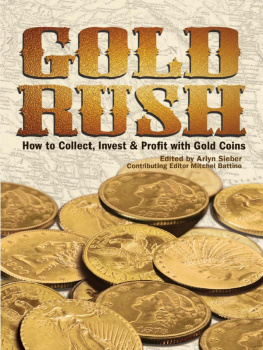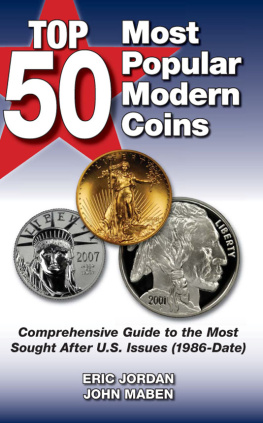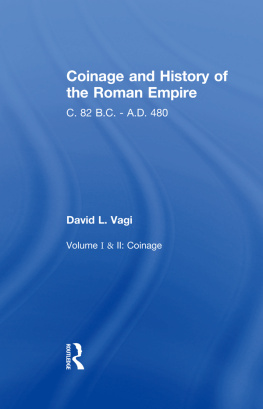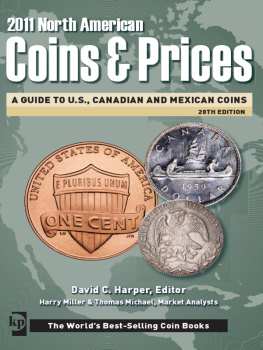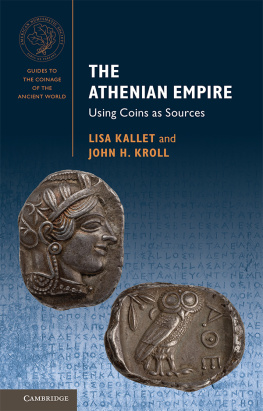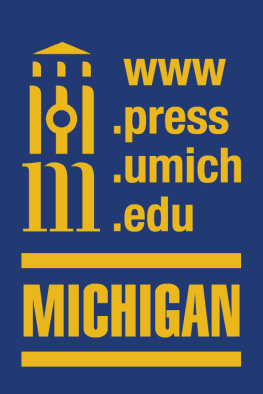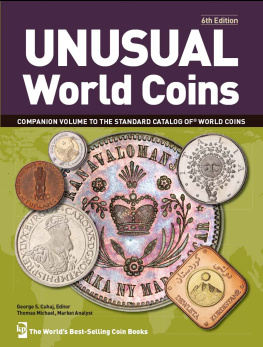C. Howgego - Ancient History From Coins
Here you can read online C. Howgego - Ancient History From Coins full text of the book (entire story) in english for free. Download pdf and epub, get meaning, cover and reviews about this ebook. year: 1995, publisher: Routledge, genre: Romance novel. Description of the work, (preface) as well as reviews are available. Best literature library LitArk.com created for fans of good reading and offers a wide selection of genres:
Romance novel
Science fiction
Adventure
Detective
Science
History
Home and family
Prose
Art
Politics
Computer
Non-fiction
Religion
Business
Children
Humor
Choose a favorite category and find really read worthwhile books. Enjoy immersion in the world of imagination, feel the emotions of the characters or learn something new for yourself, make an fascinating discovery.
- Book:Ancient History From Coins
- Author:
- Publisher:Routledge
- Genre:
- Year:1995
- Rating:3 / 5
- Favourites:Add to favourites
- Your mark:
- 60
- 1
- 2
- 3
- 4
- 5
Ancient History From Coins: summary, description and annotation
We offer to read an annotation, description, summary or preface (depends on what the author of the book "Ancient History From Coins" wrote himself). If you haven't found the necessary information about the book — write in the comments, we will try to find it.
Ancient History From Coins — read online for free the complete book (whole text) full work
Below is the text of the book, divided by pages. System saving the place of the last page read, allows you to conveniently read the book "Ancient History From Coins" online for free, without having to search again every time where you left off. Put a bookmark, and you can go to the page where you finished reading at any time.
Font size:
Interval:
Bookmark:

Coins are a rich source of information for the ancient historian; yet too often historians are uneasy about using them as evidence because of the special problems attached to their interpretation. Ancient History from Coins demystifies this specialized subject and introduces students to the techniques, methods, problems and advantages of using coins in the study of ancient history.
Christopher Howgego shows through numerous examples how the character, patterns and behaviour of coinage bear on major historical themes. Covering the period from the invention of coinage (c. 600 BC) until the reign of Diocletian, this study examines topics ranging from state finance and economic history to imperial domination and political propaganda.
Students and teachers of ancient history will find Ancient History from Coins an indispensable guide to using the evidence provided by coins in their studies.
Christopher Howgego is the curator responsible for Roman coins at the Ashmolean Museum in Oxford, and a lecturer in Roman numismatics at the University of Oxford. He has taught and written extensively on ancient coinage.
The sources for the study of the Greek and Roman world are diffuse, diverse, and often complex, and special training is needed in order to use them to the best advantage in constructing a historical picture.
The books in this series provide an introduction to the problems and methods involved in the study of ancient history. The topics covered will range from the use of literary sources for Greek history and for Roman history, through numismatics, epigraphy, and dirt archaeology, to the use of legal evidence and of art and artefacts in chronology. There will also be books on statistical and comparative method, and on feminist approaches.
The Uses of Greek Mythology
Ken Dowden
Art, Artefacts, and Chronology in Classical Archaeology
William R. Biers
Reading Papyri, Writing Ancient History
Roger S. Bagnall
Christopher Howgego

First published 1995
by Routledge
2 Park Square, Milton Park, Abingdon, Oxon, OX14 4RN
Simultaneously published in the USA and Canada
by Routledge
270 Madison Ave, New York NY 10016
Reprinted 1997
Transferred to Digital Printing 2005
1995 Christopher Howgego
Typeset in Baskerville by Florencetype Ltd, Stoodleigh, Devon
All rights reserved. No part of this book may be reprinted or reproduced or utilized in any form or by any electronic mechanical, or other means, now known or hereafter invented, including photocopying and recording, or in any information storage or retrieval system, without permission in writing from the publishers.
British Library Cataloguing in Publication Data
A catalogue record for this book is available from the British Library
Library of Congress Cataloguing in Publication Data
A catalogue record for this book is available
ISBN 0415089921 (hbk)
ISBN 041508993X (pbk)
Plates appear between pages 170 and 171. A detailed key may be found on pp. 16270. Numbers in square brackets in the text refer to the coins in the plates.
| Archaic and classical |
| Western Asia Minor |
| Italy and Sicily |
| Mainland Greece |
| The Persian empire |
| Philip II and Alexander |
| Hellenistic |
| Balkans |
| Asia Minor: regal and imperial issues |
| Asia Minor: civic issues |
| East |
| Egypt and North Africa |
| Roman Republican |
| Bronze |
| The west |
| Gold and silver |
| Roman Imperial to AD 300 |
| Western Celtic |
| Roman provincial coinage |
| Roman imperial: fourth century AD |
| Ingots |
This book is intended for students and teachers of ancient history who want to know how the study of coinage can be of interest to them. Its aim is to show how the character, patterns, and behaviour of coinage bear on major historical themes, and to introduce the principal numismatic approaches by reference to some of the more cogent examples. In addition, it is hoped that individual chapters will be of some use as essays in interpretation for those who already have a knowledge of numismatics. The book covers the period from the beginning of coinage, one side or other of 600 BC, until the reign of Diocletian. Where appropriate it ranges backwards to look at the history of money before coinage, and onwards into the fourth century AD to bring out contrasts with what happened earlier.
The first chapter is concerned with money, an important branch of history for which coinage is naturally a major source (although documentary evidence is important where it exists, particularly for describing money-use). The second discusses some of the aspects of the production of coinage which are fundamental to an appreciation of how to use coins as an historical source. The central chapters explore the relationship between empires and local coinages as an aspect of imperialism, and the implications of political iconography for state ideology. The final two chapters are broadly economic. I had intended to write on trade rather than circulation, but it became increasingly clear that to do so was to prejudge important questions, and to circumscribe radically the range of issues which may be illuminated by the movement of coin. The final chapter looks at what may be learned from coinages under pressure, about the nature of financial and economic crises.
The treatment is thematic, therefore, and the focus is on historical topics. A sketch of the history of coinage is given in numismatic methodology emerges as the book progresses, but neither is the main object of the exercise. Good introductions to both are available already (history: Carradice and Price 1988; Kraay 1976; Mrkholm 1991; Crawford 1985; Burnett 1987; methodology: Crawford 1983a; Burnett 1991).
No attempt is made to catalogue the historical events or other phenomena recorded on coins (and sometimes only on coins). The use of coins in a purely documentary fashion may be important, but it is too obvious to require a book to describe it.
I opted for the title Ancient History from Coins because the book deals with historical questions which arise out of the existence and nature of coinage, rather than to demonstrate what coins can tell us that other sources cannot. Coins are one source among many which contribute to our knowledge of the past, and no source can (or, at any rate, should) be viewed in isolation. If any reader feels that the title is inadequate because the book concerns the relationship between coinage and history, rather than a one-way flow from coins to history, I should be delighted by the criticism. I should also like to apologize to anyone who regards my use of the word ancient as unwarranted. Much of the ancient world is not treated here, but the coverage does extend beyond Graeco-Roman civilization and beyond the Mediterranean, and I could not think of a better word.
Next pageFont size:
Interval:
Bookmark:
Similar books «Ancient History From Coins»
Look at similar books to Ancient History From Coins. We have selected literature similar in name and meaning in the hope of providing readers with more options to find new, interesting, not yet read works.
Discussion, reviews of the book Ancient History From Coins and just readers' own opinions. Leave your comments, write what you think about the work, its meaning or the main characters. Specify what exactly you liked and what you didn't like, and why you think so.

